brakes PONTIAC BONNEVILLE 2003 Owner's Manual
[x] Cancel search | Manufacturer: PONTIAC, Model Year: 2003, Model line: BONNEVILLE, Model: PONTIAC BONNEVILLE 2003Pages: 418, PDF Size: 20.24 MB
Page 301 of 418
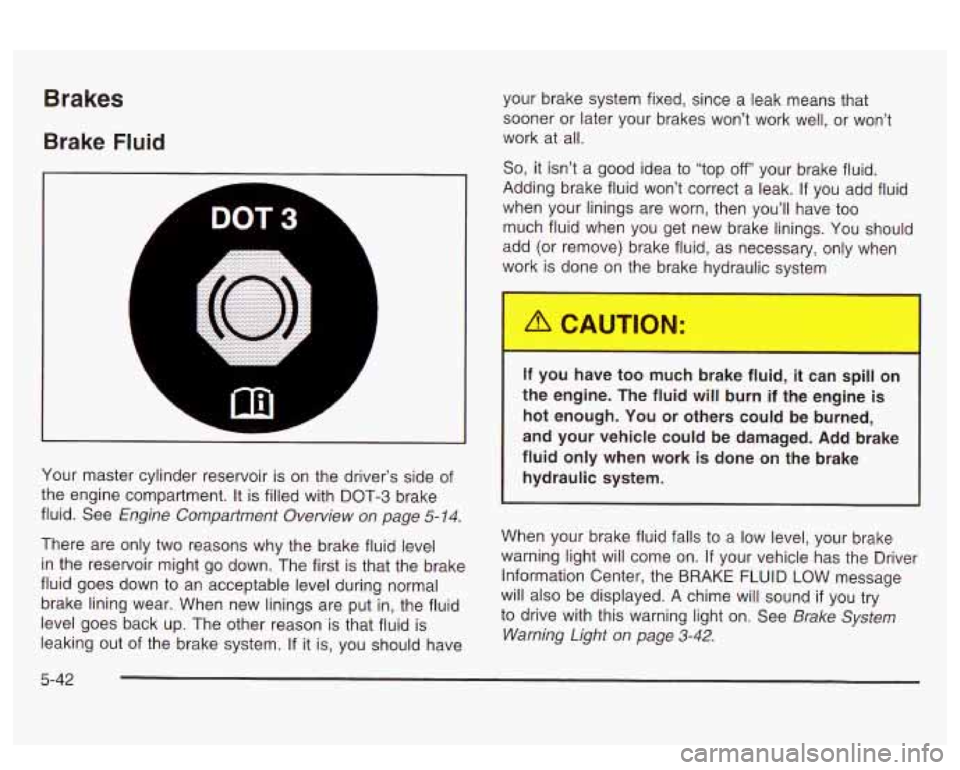
Brakes
Brake Fluid
I 1
your brake system fixed, since a leak means that
sooner or later your brakes won’t work well, or won’t
work at all.
So, it isn’t a good idea to “top off your brake fluid.
Adding brake fluid won’t correct a leak.
If you add fluid
when your linings are worn, then you’ll have too
much fluid when you get new brake linings. You should
add (or remove) brake fluid, as necessary, only when
work
is done on the brake hydraulic system
Your master cylinder reservoir is on the driver’s side of
the engine compartment. It is filled with DOT-3 brake
fluid. See
Engine Compartment Overview on page 5-14.
There are only two reasons why the brake fluid level
in the reservoir might go down. The first is that the brake
fluid goes down to an acceptable level during normal
brake lining wear. When new linings are put in, the fluid
level goes back up. The other reason is that fluid is
leaking out of the brake system.
If it is, you should have
If you have too much brake fluid, it can spill on
the engine. The fluid will burn if the engine
is
hot enough. You or others could be burned,
and your vehicle could be damaged. Add brake
fluid only when work
is done on the brake
hydraulic system.
When your brake fluid falls to a low level, your brake
warning light will come on. If your vehicle has the Driver
Information Center, the BRAKE FLUID LOW message
will also be displayed. A chime will sound
if you try
to drive with this warning light on. See
Brake System
Warning Light on page
3-42.
5-42
Page 302 of 418
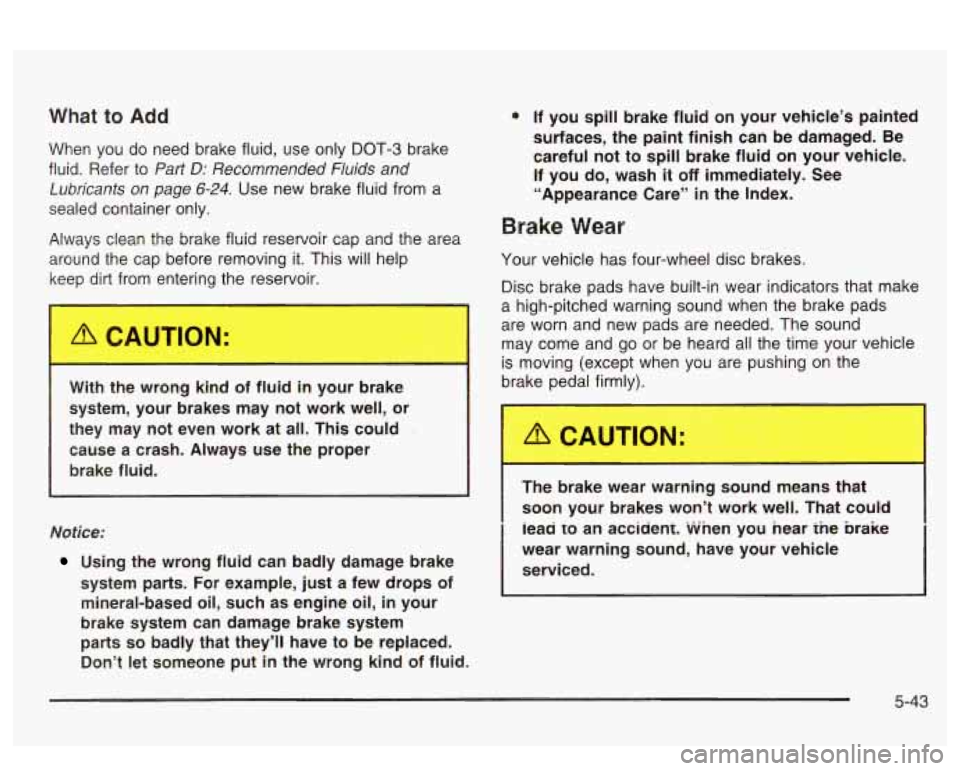
What to Add
When you do need brake fluid, use only DOT-3 brake
fluid. Refer to
Part D: Recommended Fluids and
Lubricants on page
6-24. Use new brake fluid from a
sealed container only.
Always clean the brake fluid reservoir cap and the area
around the cap before removing it. This will help
ke-- dirt from entering the reservoir.
I
With the wrong kind of fluid in your brake
system, your brakes may not work well, or
they may not even work at all. This could
cause a crash. Always use the proper
brake fluid.
* If you spill brake fluid on your vehicle’s painted
surfaces, the paint finish can be damaged. Be
careful not to spill brake fluid on your vehicle.
If you do, wash
it off immediately. See
“Appearance Care” in the Index.
Brake wear
Your vehicle has four-wheel disc brakes.
Disc brake pads have built-in wear indicators that make
a high-pitched warning sound when the brake pads
are worn and new pads are needed. The sound
may come and go or be heard all the time your vehicle
is moving (except when you are pushing on the
brake pedal firmly).
Notice:
Using the wrong fluid can badly damage brake
system parts. For example, just a few drops of mineral-based oil, such as engine oil,
in your
brake system can damage brake system
parts
so badly that they’ll have to be replaced.
Don’t let someone put in the wrong kind of fluid. The brake
wear warning sound --jeans that
soon your brakes won’t work well. That could
lead
KO an accident. wnen you near ine brake
wear warning sound, have your vehicle
serviced.
5-43
Page 303 of 418
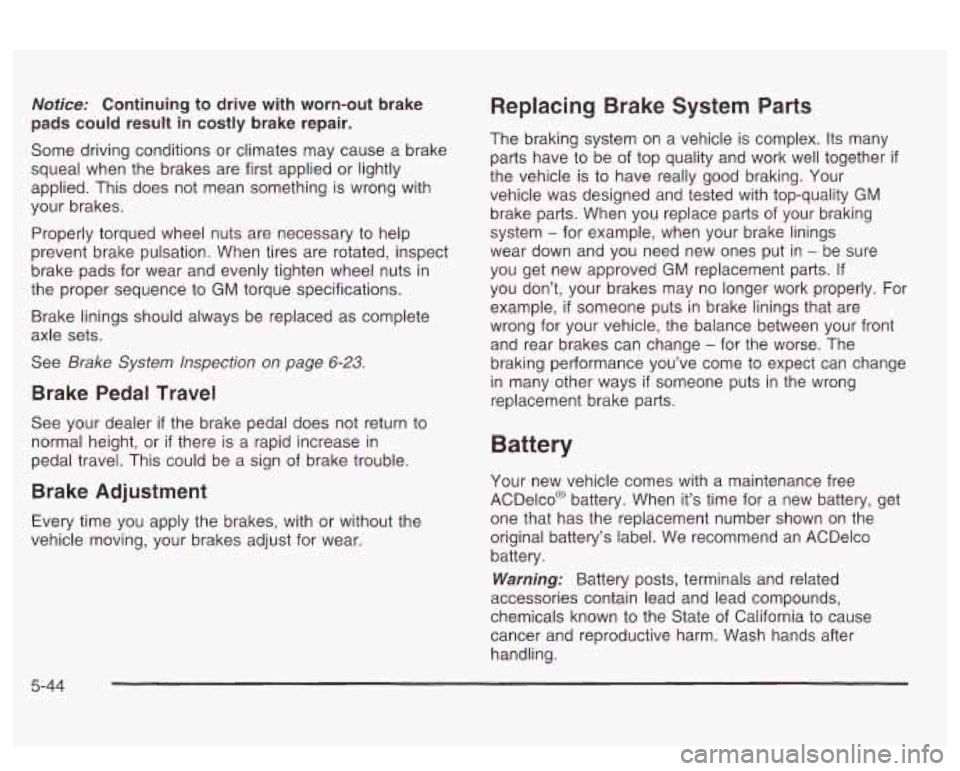
Notice: Continuing to drive with worn-out brake
pads could result in costly brake repair.
Some driving conditions or climates may cause a brake
squeal when the brakes are first applied or lightly
applied. This does not mean something
is wrong with
your brakes.
Properly torqued wheel nuts are necessary to help
prevent brake pulsation. When tires are rotated, inspect
brake pads for wear and evenly tighten wheel nuts in
the proper sequence to GM torque specifications.
Brake linings should always be replaced as complete
axle sets.
See
Brake System Inspection on page 6-23.
Brake Pedal Travel
See your dealer if the brake pedal does not return to
normal height, or
if there is a rapid increase in
pedal travel. This could be a sign of brake trouble.
Brake Adjustment
Every time you apply the brakes, with or without the
vehicle moving, your brakes adjust for wear.
Replacing Brake System Parts
The braking system on a vehicle is complex. Its many
parts have to be of top quality and work well together
if
the vehicle is to have really good braking. Your
vehicle was designed and tested with top-quality GM
brake parts. When you replace parts of your braking
system
- for example, when your brake linings
wear down and you need new ones put in
- be sure
you get new approved GM replacement parts.
If
you don’t, your brakes may no longer work properly. For
example,
if someone puts in brake linings that are
wrong for your vehicle, the balance between your front
and rear brakes can change
- for the worse. The
braking performance you’ve come to expect can change
in many other ways
if someone puts in the wrong
replacement brake parts.
Battery
Your new vehicle comes with a maintenance free
ACDelco@ battery. When it’s time for a new battery, get
one that has the replacement number shown on the
original battery’s label. We recommend an ACDelco
battery.
Warning: Battery posts, terminals and related
accessories contain lead and lead compounds,
chemicals known to the State of California to cause
cancer and reproductive harm. Wash hands after
handling.
5-44
Page 330 of 418
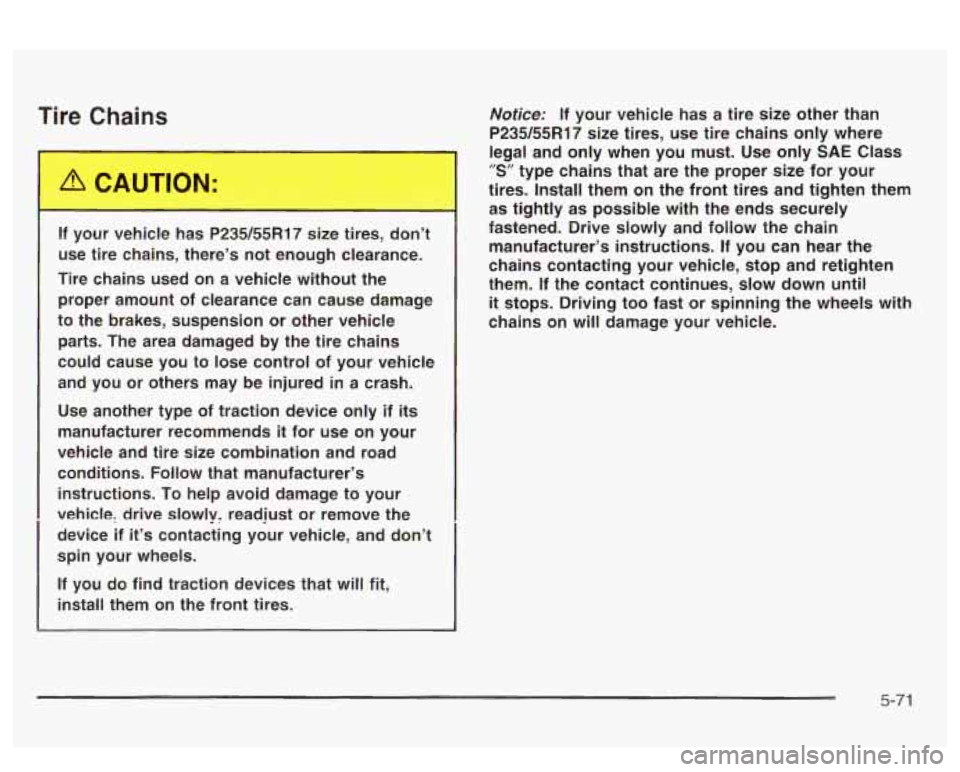
Tire Chains
If your vehicle has P235/55R17 size tires, don’t
use tire chains, there’s not enough clearance.
Tire chains used on a vehicle without the proper amount of clearance can cause damage
to the brakes, suspension or other vehicle
parts. The area damaged by the tire chains
could cause you
to lose control of your vehicle
and you or others may be injured in a crash.
Use another type of traction device only if
its
manufacturer recommends it for use on your
vehicle and tire size combination and road
conditions.
Follow that manufacturer’s
instructions.
To help avoid damage to your
vehicle, drive slowly, readjust or remove the
device if it’s contacting your vehicle, and don’t
spin your wheels.
If you do find traction devices that will
fit,
install them on the front tires.
Notice: If your vehicle has a tire size other than
P235/55R17 size tires, use tire chains only where
legal and only when you must. Use only
SAE Class
”S” type chains that are the proper size for your
tires. Install them on the front tires and tighten them as tightly as possible with the ends securely
fastened. Drive slowiy and follow the chain manufacturer’s instructions. If you can hear the
chains contacting your vehicle, stop and retighten
them. If the contact continues,
slow down until
it stops. Driving too fast or spinning the wheels with
chains on will damage your vehicle.
5-7 1
Page 368 of 418
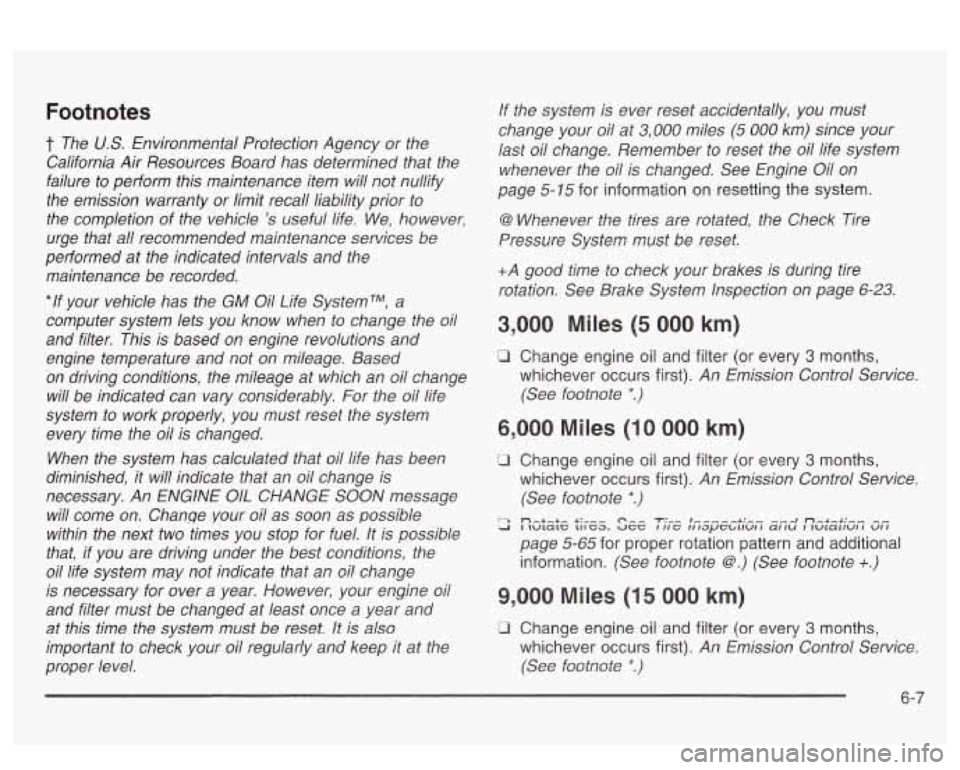
Footnotes
t The U.S. Environmental Protection Agency or the
California Air Resources Board has determined that the
failure to perform this maintenance item will not nullify
the emission warranty or limit recall liability prior to
the completion of the vehicle
's useful life. We, however,
urge that all recommended maintenance services be
performed at the indicated intervals and the
maintenance be recorded.
*If your vehicle has the GM Oil Life SystemTM,
a
computer system lets you know when to change the oil
and filter. This is based on engine revolutions and
engine temperature and not on mileage. Based
on driving conditions, the mileage at which an oil change
will be indicated can vary considerably. For the oii life
system to work properly, you must reset the system
every time the oil is changed.
When the system has calculated that oil life has been
diminished, it will indicate that an oil change is
necessary. An ENGINE
OIL CHANGE SOON message
will come on. Change your oil as soon as possible
within the next two times you stop for fuel. It is possible
that, if you are driving under the best conditions, the
oil life system may not indicate that an oil change
is necessary for over a year. However, your engine oil
and filter must be changed at least once a year and
at this time the system must be reset. It is also
important to check your oil regularly and keep it at the
proper level.
If the system is ever reset accidentally, you must
change your oil at 3,000 miles
(5 000 km) since your
last oil change. Remember to reset the oil life system
whenever the oil is changed. See Engine Oil on
page
5-15 for information on resetting the system.
@ Whenever the tires are rotated, the Check Tire
Pressure §ystem must be reset.
+A good time to check your brakes is during tire
rotation. See Brake System Inspection on page 6-23.
3,000 Miles (5 000 km)
0 Change engine oil and filter (or every 3 months,
whichever occurs first).
An Emission Control Service.
(See footnote
*.)
6,000 Miles (IO 000 km)
u
n U
Change engine oil and filter (or every 3 months,
whichever occurs first).
An Emission Control Service.
(See footnote
*.)
page 5-65 for proper rotation pattern and additional
information.
(See footnote @.) (See footnote +.)
n-4-4- r?-- -I-:-- I 4:-- -...A n-+-+:-- -- I wlalc LII ~a. UGG I 11 G 11 I~JG~LIVII a1 IU I IvLauvII VII
9,000 Miles (15 000 km)
U Change engine oil and filter (or every 3 months,
whichever occurs first).
An Emission Control Service.
(See footnote
*.)
6-7
Page 374 of 418

Long Trip/Highway Scheduled
Maintenance
The services shown in this schedule up to 100,000 miles
(166
000 km) should be repeated after 100,000 miles
(1 66 800 km) at the same intervals for the life of
this vehicle. The services shown at 150,000 miles
(240 000 km) should be repeated at the same interval
after 150,000 miles
(240 000 km) for the life of this
vehicle.
See
Part B: Owner Checks and Services on page 6-18
and Part C: Periodic Maintenance Inspections on
page 6-22.
t The U.S. Environmental Protection Agency or the
California Air Resources Board has determined that the
failure to perform this maintenance item will not nullify
the emission warranty or limit recall liability prior to
the completion of the vehicle
's useful life. We, however,
urqe that all recommended maintenance services be
performed at the indicated intervals and the
maintenance be recorded.
* If your vehicle has the GM Oil Life SystemTM, a
computer system lets you know when to change the
engine oil and filter. This is based on engine revolutions
aiid eiigifie telvpei-atdre, and ncf c:: ml?eage. Based
on driving conditions, the mileage at which an oil
change will be indicated can vary considerably. For the
oil life system to work properly, you must reset the
system every time the oil is changed.
When the system has calculated that oil life has been
diminished, it wil! indicate that an oil change is
necessary. An ENGINE
OIL CHANGE SOON message
will come on. Change your oil as soon as possible
within the next two times you stop for fuel. It is possible
that, if you are driving under the best conditions, the
oil life system may not indicate that an oil change
is necessary for over a year. However, your engine
oil
and filter must be changed at least once a year and
at this time the system must be reset. It is also
important to check your oil regularly and keep it at the
proper level.
If the system is ever reset accidentally, you must
change your oil at
3,000 miles (5 000 km) since your
last oil change. Remember to reset the oil life system
whenever the oil is changed. See Engine Oil on
page
5-75 for information on resetting the system.
@ Whenever the tires are rotated, the Check Tire
Pressure System must be reset.
+ A good time to check your brakes is during tire
rotation. See Brake System Inspection on page
6-23.
6-1 3
Page 384 of 418
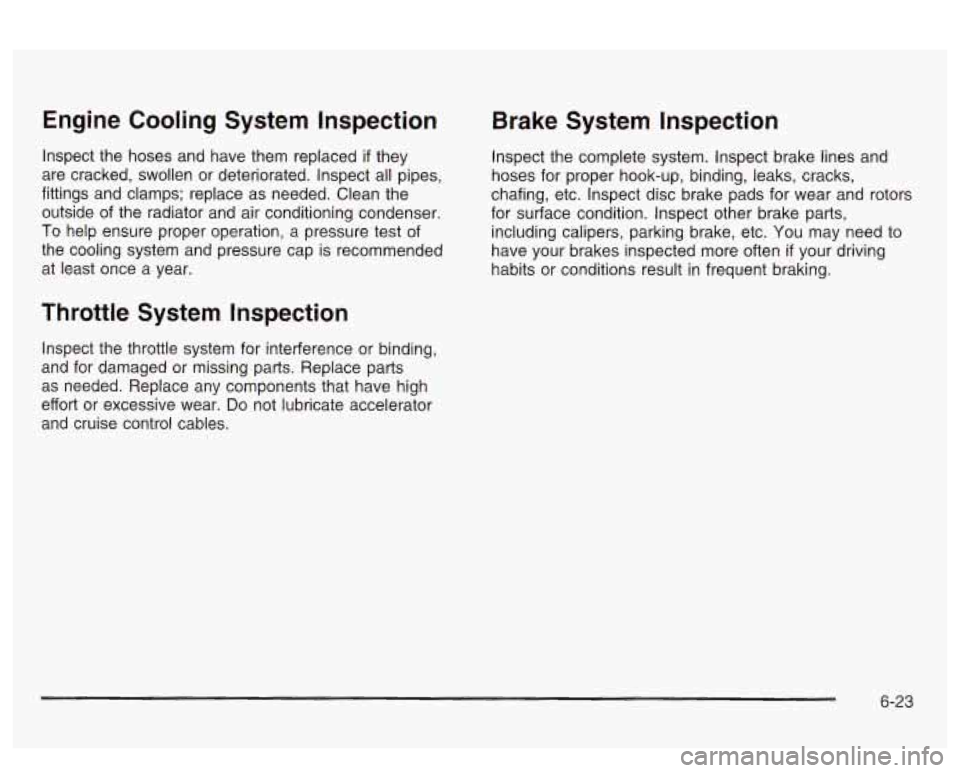
Engine Cooling System Inspection
Inspect the hoses and have them replaced if they
are cracked, swollen or deteriorated. Inspect all pipes,
fittings and clamps; replace as needed. Clean the
outside of the radiator and air conditioning condenser.
To help ensure proper operation, a pressure test of
the cooling system and pressure cap is recommended
at least once a year.
Throttle System Inspection
Inspect the throttle system for interference or binding,
and for damaged or missing parts. Replace parts
as needed. Replace any components that have high
effort or excessive wear.
Do not lubricate accelerator
and cruise control cables.
Brake System Inspection
Inspect the complete system. Inspect brake lines and
hoses for proper hook-up, binding, leaks, cracks,
chafing, etc. Inspect disc brake pads for wear and rotors
for surface condition. Inspect other brake parts,
including calipers, parking brake, etc. You may need to
have your brakes inspected more often
if your driving
habits or conditions result in frequent braking.
6-23
Page 398 of 418
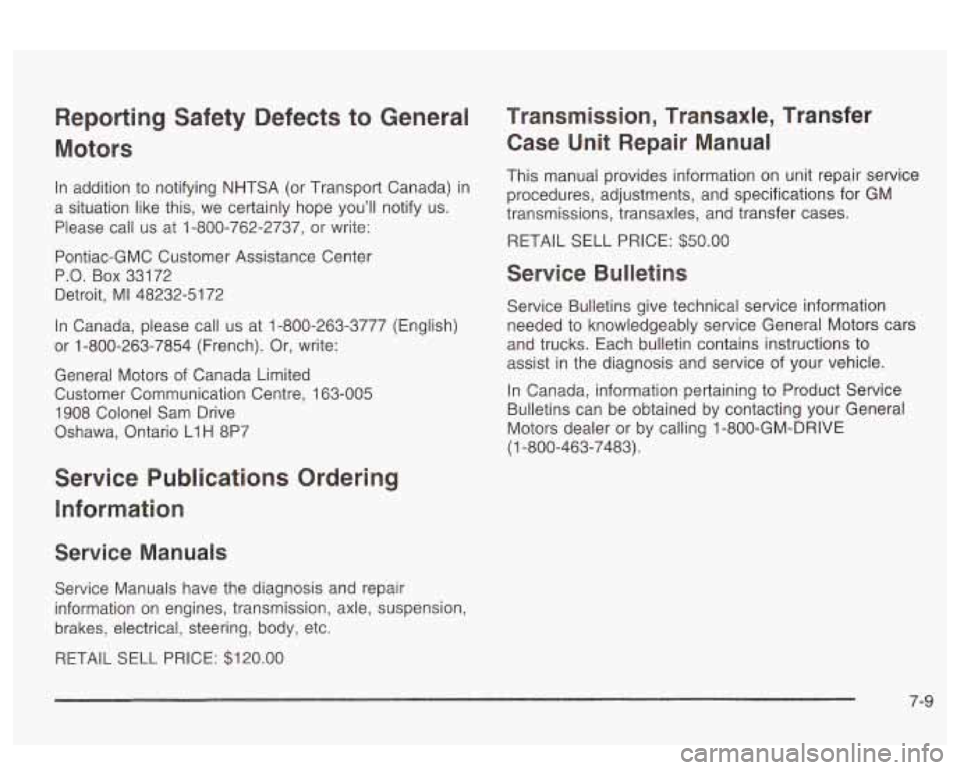
orting Safety Defects to General
Motors
In addition to notifying NHTSA (or Transport Canada) in
a situation like this, we certainly hope you’ll notify us.
Please call us at i-800-762-2737, or write:
Pontiac-GMC Customer Assistance Center
P.O. Box 33172
Detroit,
MI 48232-5172
In Canada, please call us at 1-800-263-3777 (English)
or 1-800-263-7854 (French). Or, write:
General Motors
of Canada Limited
Customer Communication Centre,
163-005
1908 Colonel Sam Drive
Oshawa, Ontario LIH
8P7
Service Publications Ordering
Information
Service Manuals
Service Manuals have the diagnosis and repair
information on engines, transmission, axle, suspension,
brakes; electrical; steering: body, etc.
Transmission, Transaxle, Transfer
Case Unit Repair Manual
This manual provides information on unit repair service
procedures, adjustments, and specifications for GM
transmissions, transaxles, and transfer cases.
RETAIL SELL PRICE:
$50.00
Service Bulletins
Service Bulletins give technical service information
needed to knowledgeably service General Motors cars
and trucks. Each bulletin contains instructions to
assist in the diagnosis and service of your vehicle.
In Canada, information pertaining to Product Service
Bulletins can be obtained by contacting your General
Motors dealer or by calling 1-800-GM-DRIVE
(1 -800-463-7483).
RETAIL SELL PRICE:
$120.00
7-9
Page 401 of 418
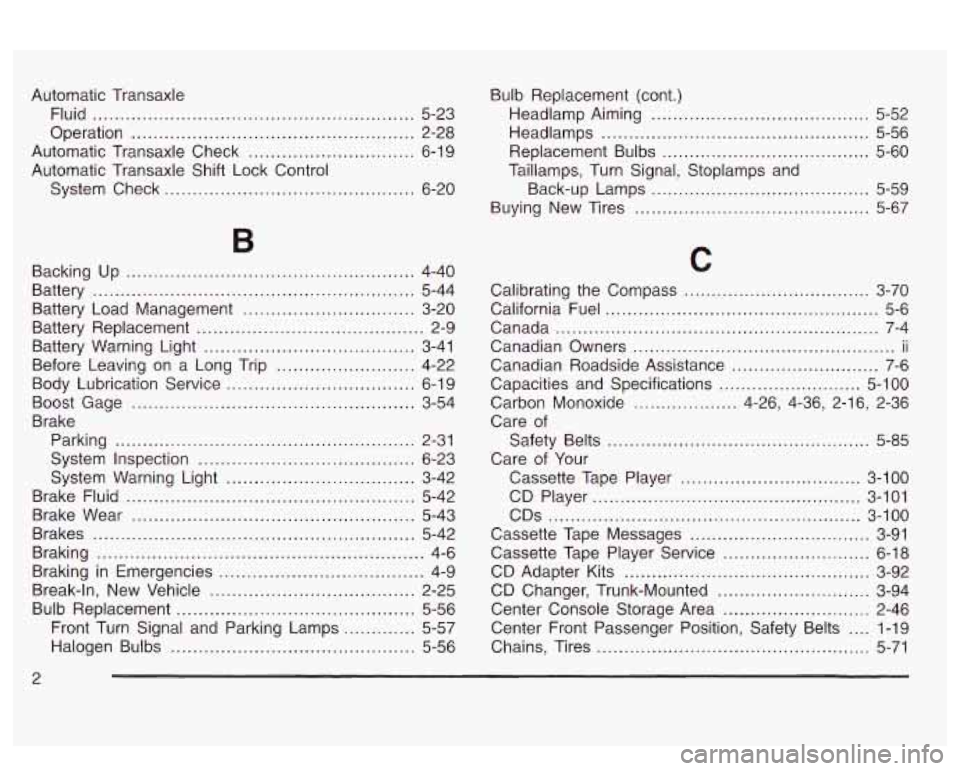
Automatic Transaxle Fluid
.......................................................... 5-23
Operation
................................................... 2-28
Automatic Transaxle Check
.............................. 6-1 9
Automatic Transaxle Shift Lock Control
System Check
......................................... 6-20
Backing Up
................................................. 4-40
Battery
.......................... ......................... 5-44
Battery Load Management
............................ 3-20
Battery Replacement
......................................... 2-9
Battery Warning Light
...................................... 3-41
Before Leaving on a Long Trip
......................... 4-22
Body Lubrication Service
.................................. 6-1 9
Boost Gage
................................................... 3-54
Brake
Parking
...................................................... 2-31
System Inspection
....................................... 6-23
Brake Fluid
.................................................... 5-42
Brake Wear
................................................... 5-43
Brakes
.......................................................... 5-42
Braking
........................................................... 4-6
Braking in Emergencies
..................................... 4-9
Break-In, New Vehicle
..................................... 2-25
Bulb Replacement
........................................... 5-56
Front Turn Signal and Parking Lamps ............. 5-57
Halogen Bulbs
............................................ 5-56
System Warning
Light
.................................. 3-42 Bulb
Replacement (cont.)
Headlamp Aiming
........................................ 5-52
Headlamps
................................................. 5-56
Replacement Bulbs
...................................... 5-60
Taillamps. Turn Signal. Stoplamps and Back-up Lamps
........................................ 5-59
Buying New Tires
........................................... 5-67
C
Calibrating the Compass .................................. 3-70
California Fuel
.................................................. 5-6
Canada
........................................................... 7-4
Canadian Owners ................................................ ii
Canadian Roadside Assistance ........................... 7-6
Capacities and Specifications
.......................... 5-1 00
Carbon Monoxide ................... 4-26, 4-36, 2-16, 2-36
Care
of
Care of Your
Safety Belts
............................................ 5-85
Cassette Tape Player
................................. 3-100
CD Player
................................................. 3-101
CDS
......................................................... 3-100
Cassette Tape Messages
................................. 3-91
Cassette Tape Player Service
........................... 6-18
CD Adapter Kits
............................................. 3-92
CD Changer, Trunk-Mounted
............................ 3-94
Center Console Storage Area
........................... 2-46
Center Front Passenger Position, Safety Belts
.... 1-19
Chains, Tires
.................................................. 5-71
2
Page 413 of 418
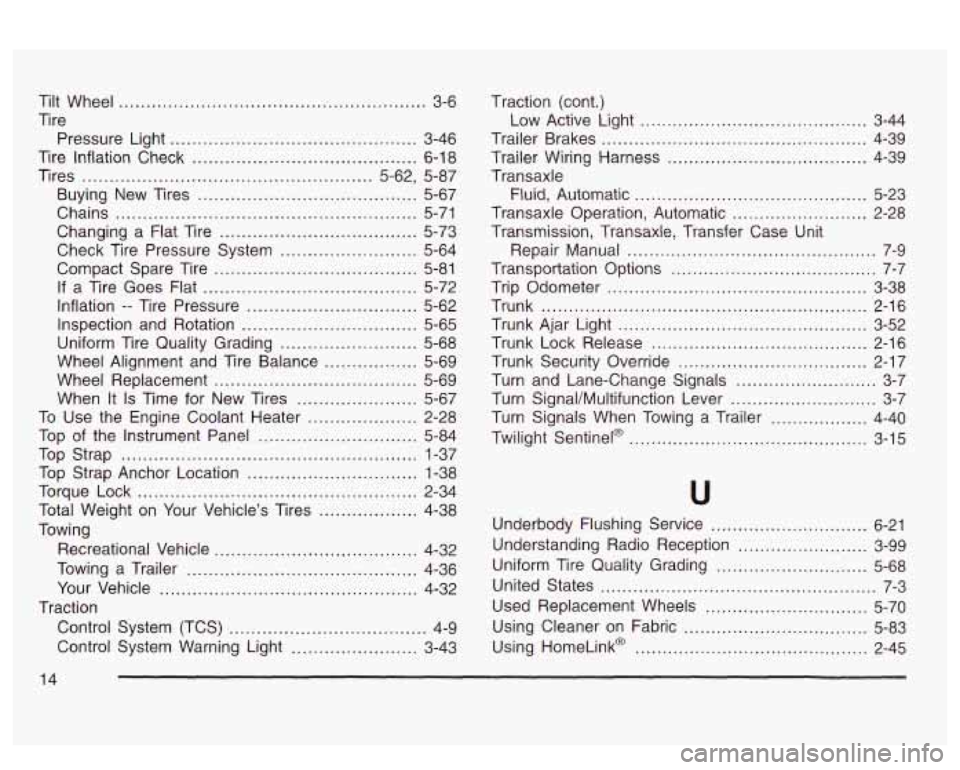
Tilt Wheel ................. ............ 3-6
Ti re
Pressure Light
................ .................. 3-46
Tire inflation Check
......................................... 6-18
Ti res ................................... .......... 5.62. 5-87
Buying New Tires
....... ...................... 5-67
Chains
....................................................... 5-71
Changing a Flat Tire
.................................... 5-73
Check Tire Pressure System
......................... 5-64
Compact Spare Tire
..................................... 5-81
If a Tire Goes Flat ....................................... 5-72
Inflation
-- Tire Pressure ............................... 5-62
Inspection and Rotation
................................ 5-65
Uniform Tire Quality Grading
......................... 5-68
Wheel Alignment and Tire Balance
................. 5-69
Wheel Replacement
..................................... 5-69
When It
Is Time for New Tires ...................... 5-67
To Use the Engine Coolant Heater
.................... 2-28
Top
of the Instrument Panel ............................. 5-84
Top Strap
...................................................... 1-37
Top Strap Anchor Location
............................... 1-38
Torque Lock
................................................... 2-34
Total Weight on Your Vehicle’s Tires
.................. 4-38
Towing
Recreational Vehicle
..................................... 4-32
Towing a Trailer
.......................................... 4-36
Your Vehicle
............................................... 4-32
Control System (TCS)
.................................... 4-9
Control System Warning Light
....................... 3-43
Traction Traction
(cont.)
Low Active Light
...................................... 3-44
Trailer Brakes
................................................. 4-39
Trailer Wiring Harness
..................................... 4-39
Transaxle
Fluid. Automatic
........................................... 5-23
Transaxle Operation. Automatic
......................... 2-28
Transmission. Transaxle. Transfer Case Unit
Repair Manual
.............................................. 7-9
Transportation Options
...................................... 7-7
Trip Odometer
................................................ 3-38
Trunk
........................................................ 2-16
Trunk Ajar Light
.............................. .... 3-52
Trunk Lock Release
.................................... 2-16
Trunk Security Override
............................... 2-17
Turn and Lane-Change Signals
.......................... 3-7
Turn Signal/Multifunction Lever
........................... 3-7
Turn Signals When Towing a Trailer
.................. 4-40
Twilight Sentinel@
............................................ 3-15
U
Underbody Flushing Service ............................. 6-21
Understanding Radio Reception
........................ 3-99
Uniform Tire Quality Grading
............................ 5-68
United States
................................................... 7-3
Used Replacement Wheels
.............................. 5-70
Using Cleaner on Fabric .................................. 5-83
Using HomeLink@ ........................................... 2-45
14